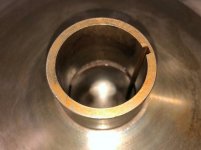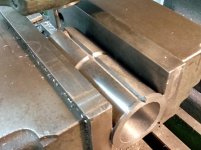Peter.
Titanium
- Joined
- Mar 28, 2007
- Location
- England UK
I'm servicing the vari-speed pulleys and speed adjuster on my HLV and I thought I'd put up some pics. I have two problems, one is that the centre sheave is a bit loose so rattles as it rocks every revolution, the other is that the screw jack adjuster had slightly worn threads and the cross pin is also a little loose in the hole, allowing the frame to jump about a bit so I intend to make a new cross pin and ream the hold slightly bigger.
First the sheaves. When I stripped the bearings out (which were actually pretty good) to fit new ones I dumped the whole lot in some brake cleaner because the sliding action of the middle sheave was a bit 'gummy' and it let out a whole mess of dark red sludge - too 'red' to be rust so I imagine that it's evidence of wear from some kind of bush inside. The middle sheave does have a bit of rock to it as I said.

Since I pulled the bearings I'm a little confounded as to how to strip the rest apart. It seems like the end sheaves are brazed or silver soldered to the shaft. I did a search of old threads and found one where the ends were threaded on & secured with a roll pin, and another where they had been brazed as part of a 'repair'. Here is mine.



And there are two cross-drilled holes in the shaft which I'll find out the purpose of later.

Since I can't find any pics of the internal parts of the sheaves I am a bit lost as to how to approach this. If the wear is commonly in the shaft I could turn that out and make a new one. If I knew that the brazing was only a shallow groove filled with braze I could try to carefully turn that out. If anyone has any experience or constructive input I'd really like to hear it before I take the plunge.
Pete.
First the sheaves. When I stripped the bearings out (which were actually pretty good) to fit new ones I dumped the whole lot in some brake cleaner because the sliding action of the middle sheave was a bit 'gummy' and it let out a whole mess of dark red sludge - too 'red' to be rust so I imagine that it's evidence of wear from some kind of bush inside. The middle sheave does have a bit of rock to it as I said.

Since I pulled the bearings I'm a little confounded as to how to strip the rest apart. It seems like the end sheaves are brazed or silver soldered to the shaft. I did a search of old threads and found one where the ends were threaded on & secured with a roll pin, and another where they had been brazed as part of a 'repair'. Here is mine.



And there are two cross-drilled holes in the shaft which I'll find out the purpose of later.

Since I can't find any pics of the internal parts of the sheaves I am a bit lost as to how to approach this. If the wear is commonly in the shaft I could turn that out and make a new one. If I knew that the brazing was only a shallow groove filled with braze I could try to carefully turn that out. If anyone has any experience or constructive input I'd really like to hear it before I take the plunge.
Pete.


 .
.













